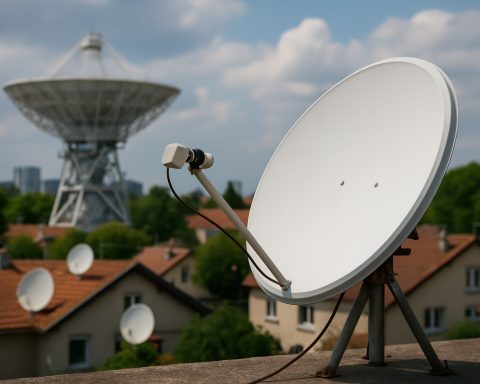- Nvidia’s GeForce RTX 5090 debuts amid supply constraints and skyrocketing prices, challenging consumer access.
- PowerGPU and other PC makers face increased costs and customer backlash amidst accusations of price gouging.
- The RTX 5090’s price surge—from an initial $1,999 to beyond $3,050—reflects wider market and geopolitical pressures.
- Tariffs add further strain, with a 20% levy exacerbating the cost issues for consumers and manufacturers alike.
- Nvidia acknowledges the supply climate, advocating patience as gamers and enthusiasts await broader availability.
- The situation highlights a broader industry dilemma: the challenge of balancing innovation and accessibility.
Amidst a swirling saga of supply constraints and sticker shock, Nvidia’s GeForce RTX 5090 has burst onto the scene, leaving both consumers and industry stalwarts in turmoil. As whispered rumors of the card’s prowess waft through online forums, the stark reality emerges starkly—availability remains a distant dream for most, and only those with deep pockets can dare to imagine possession.
Visualize PowerGPU, a distinguished name in custom PC builds, navigating a tempest of escalating costs, unable to wrestle promised low prices out of a market mired in chaos. The company’s CEO, a battler in the trenches of technology, publicly aired his grievances this week, pulling back the curtain on an industry squeezed by its own success.
The RTX 5090 promised to revolutionize gaming experiences, but its revolutionary potential is dimmed by its jaw-dropping price tag. Initially set to start at $1,999, the card has been nudged skyward, with vendors witnessing quotes soaring above $3,050—and that’s a conservative estimate, leaving owners of even moderately priced custom desktops staring down the barrel of $5,000.
With palpable frustration, the team at PowerGPU finds themselves accused of price gouging by customers unaware of the inner machinations of hardware pricing. Yet, they are not alone. Other prominent PC makers such as iBUYPOWER and Maingear mirror these cost structures, the RTX 5090’s allure offset by a supply chain fraying under geopolitical tensions and tariffs that cast long shadows on the price tags.
A grim undercurrent of dissatisfaction runs through the community as references unravel—tariffs, once thought to be a brief hurdle, appear as formidable barriers, with a 20% levy amplifying the strain. Nvidia acknowledges the climate, urging patience, yet gamers and enthusiasts find little solace. The promise is there; the product is not.
Innovation and technology have long been the dual engines propelling us toward the future, but this development throws a stark shadow on an industry teetering at the edge of expectation and reality. For PowerGPU and others, the message is clear—the market needs more than relentless demand; it needs a rescue from its own creation.
The takeaway? Amidst impressive advancements, the world of high-tech faces a cautionary tale. As we stand on the cusp of technological nirvana, the reality lies steeper still—no progress comes without peril, and no innovation devoid of challenge. Destined for greatness, the RTX 5090 shows us that sometimes, the biggest revolutionary leap is learning to stabilize the ground beneath our feet.
Nvidia’s RTX 5090: The Cutting-Edge Graphics Card You Might Never Own
Overview and Features
The Nvidia GeForce RTX 5090 represents a significant leap in gaming and graphics performance, poised to transform how users experience visual computing. It’s outfitted with state-of-the-art architecture and cutting-edge DLSS (Deep Learning Super Sampling) technology, enhancing frame rates and image quality like never before. With increased VRAM and optimized ray tracing capabilities, it promises an unparalleled gaming experience.
Controversies and Limitations
However, this remarkable technological marvel comes bathed in controversy. Its initial promise is overshadowed by a series of challenges, including an exorbitant price point and extremely limited availability. The RTX 5090’s price, already steep at $1,999, has inflated due to supply chain woes and geopolitical influences, reaching a staggering $3,050 or more. This rarity and expense leave many potential customers disheartened.
Causes of Market Strain
Several factors contribute to the current market strain:
1. Supply Chain Disruptions: Global supply chains are being stretched thin, affecting many industries, including high-tech. The semiconductor shortage, driven by pandemic-related disruptions, has played a significant role in limiting production.
2. Geopolitical Tensions and Tariffs: An ongoing trade war has led to a 20% tariff on tech imports, further driving prices upward. This factor, coupled with fluctuating global markets, has created a less-than-ideal environment for tech development and distribution.
3. Exponential Demand: The booming interest in high-performance gaming PCs, especially since the COVID-19 pandemic, has increased demand faster than production can accommodate.
Industry Trends
In response to these challenges, some companies are exploring alternative solutions:
– Advanced Manufacturing Technologies: Tech companies are investing in more efficient production technologies to alleviate semiconductor shortages.
– Diversification of Supply: Businesses are seeking to remove production dependencies by diversifying geographic and source-specific supply chains.
Real-World Use Cases
While the RTX 5090’s price and availability remain a hurdle, its potential in real-world applications cannot be understated. From hyper-realistic gaming to professional graphic design and AI training simulators, the RTX 5090’s full capabilities could redefine these industries.
Pros and Cons Overview
Pros:
– Superior performance and advanced features
– Supports the latest gaming and software applications
– Promises longer lifecycle support for upcoming game releases
Cons:
– Prohibitive cost makes it inaccessible for many
– Limited availability due to supply constraints
– Geopolitical factors contribute to uncertainty in supply
Actionable Recommendations
For those considering entering the high-performance graphics card market:
1. Budget Wisely: Plan for potential price changes and consider additional components when upgrading your setup.
2. Stay Updated: Keep an eye on industry news to track availability and price trends.
3. Consider Alternatives: Explore previous models like the RTX 4080 or even competitors for a more cost-effective build.
4. Future-Proof Your Setup: If you manage to secure the RTX 5090, ensure your other components can support its full capabilities.
For more insights into PC building and gaming, you can visit Nvidia.
Conclusion
While the RTX 5090 shines as a beacon of technological achievement, it simultaneously serves as a reminder of the complexities involved in balancing innovation with market realities. As consumers and enthusiasts, understanding these dynamics can guide us toward making more informed choices in the ever-evolving tech landscape.





